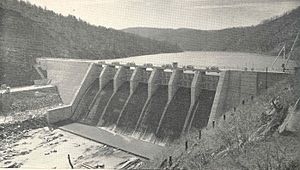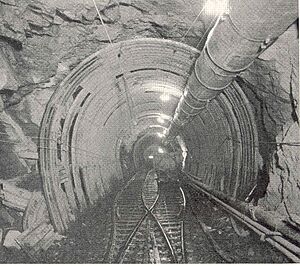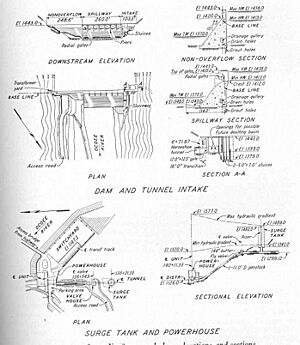Ocoee Dam No. 3 facts for kids
Quick facts for kids Ocoee Dam No. 3 |
|
|---|---|

Ocoee Dam No. 3, circa 1945
|
|
| Official name | Ocoee Dam Number 3 |
| Location | Polk County, Tennessee, United States |
| Coordinates | 35°2′26″N 84°28′0″W / 35.04056°N 84.46667°W |
| Construction began | July 17, 1941 |
| Opening date | April 30, 1943 |
| Operator(s) | Tennessee Valley Authority |
| Dam and spillways | |
| Impounds | Ocoee River |
| Height | 110 feet (34 m) |
| Length | 612 feet (187 m) |
| Reservoir | |
| Creates | Ocoee No. 3 Reservoir |
Ocoee Dam No. 3 is a large hydroelectric dam located on the Ocoee River in Polk County, Tennessee. It is one of four dams on this river, all managed by the Tennessee Valley Authority (TVA). The TVA built this dam in the early 1940s. Its main purpose was to create electricity needed during World War II.
The dam forms the Ocoee No. 3 Reservoir, which covers about 360 acres. This reservoir stretches 11 miles upriver to the border between Tennessee and Georgia. Interestingly, the power plant for Ocoee No. 3 is not right at the dam. It's located several miles downstream. Water from the reservoir travels through a 2.5-mile long pipe to reach the power plant.
Contents
Where is Ocoee Dam No. 3 Located?
Ocoee Dam No. 3 sits about 29 miles from where the Ocoee River ends. The river here cuts a deep path between two mountains: Little Frog Mountain to the north and Big Frog Mountain to the south. Both mountains are protected wilderness areas.
- Ocoee Dam No. 2 is just 5 miles downstream from this dam.
- Blue Ridge Dam is 23 miles upstream.
The Toccoa River starts in the Blue Ridge Mountains of northern Georgia. It becomes the Ocoee River when it enters Tennessee. This happens about 11 miles upstream from Ocoee Dam No. 3, near the Copperhill area. The Ocoee Scenic Byway, which is part of U.S. Route 64, passes close to the dam.
How Much Power Can Ocoee Dam No. 3 Make?
Ocoee Dam No. 3 is a concrete dam that is 110 feet tall and 612 feet long. It can produce 28,800 kilowatts of electricity. The dam has a spillway that can release a lot of water, up to 95,000 cubic feet per second. Some of this water flows through two large gates, each 5 feet by 7 feet, located at the bottom of the dam.
The Ocoee No. 3 Reservoir has 360 acres of water surface. It also has 24 miles of shoreline. During summer weekends, the dam often releases water for fun activities like whitewater rafting.
The power plant for Ocoee No. 3 was built 4.2 miles downstream from the dam. This location helps the plant use the river's drop in elevation to make more power. A special pipe, mostly a 12-foot by 12-foot tunnel carved into the mountain, carries water from the reservoir. This tunnel keeps the water at a steady height. After 2.5 miles, the water leaves the tunnel and drops 180 feet through a steel pipe called a penstock. This rushing water then spins the power plant's single turbine to create electricity.
Building the Dam: A Look Back
The Ocoee River flows very fast, making it great for producing hydroelectric power. Private companies, like the Eastern Tennessee Power Company, started building dams here a long time ago. Ocoee Dam No. 1 was finished in 1911, and Ocoee Dam No. 2 in 1913. Even with these, there was still a 47-mile stretch of river between Ocoee Dam No. 2 and Blue Ridge Dam (finished in 1931). This part of the river dropped about 46 feet per mile, which meant a third dam was possible.
The U.S. Army Corps of Engineers looked at the Ocoee No. 3 dam site in the late 1920s. A company called TEPCO had already bought the land and water rights for the dam by the 1930s.
In 1933, the TVA Act created the Tennessee Valley Authority. This new organization was put in charge of the entire Tennessee River area, including the Ocoee. In 1939, a U.S. Supreme Court decision made TEPCO sell its property to the TVA. This included the land for Ocoee No. 3.
The TVA had looked at the Ocoee No. 3 site in 1934. But the idea for the dam didn't get much attention until World War II began in Europe. The war created a huge need for more aluminum to build planes and other things. The ALCOA plant in Alcoa, Tennessee needed a lot of electricity to make aluminum. So, the Ocoee No. 3 project, along with other dam projects, was approved on July 16, 1941. Construction started the very next day.
Most of the land needed for Ocoee Dam No. 3 was already owned by TEPCO. This meant no homes or cemeteries had to be moved. Work on the dam went quickly. The dam itself was finished on August 15, 1942. The water tunnel was completed in November of the same year. However, due to money delays, the dam's generator didn't start working until April 30, 1943.
What Happened in January 2009?
On January 4, 2009, the TVA released some material from the Ocoee No. 3 Reservoir. This material was like thick mud and flowed into the river downstream. It caused harm to fish and covered the river with a layer of "foul-smelling" mud. This mud reached as far as the Ocoee No. 2 Reservoir.
The mud contained leftover materials from old mining operations in the nearby Ducktown Basin. These materials included copper, iron, and zinc. The release affected the Ocoee Whitewater Center, which is a popular spot for water sports.
The TVA stated that this release was part of regular maintenance. The material was let out through the dam's gates at the bottom, which are usually used for releasing water for recreation. After this happened, the Tennessee Department of Environment and Conservation told the TVA they needed state approval before using these gates again. They also ordered the TVA to clean up the affected areas and create a plan for how they would manage future releases from the dam.



